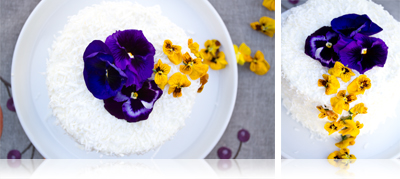How To Garnish With Edible Flowers
Edible flowers make stunning garnishes for foods and eye-catching decorations for platters, banquets, and buffet tables. Arranging them is an art. Here are some guidelines to get you started.
Provide Visual Contrast
For the flowers to really shine, they should stand out from the food. Plates can act as a frame for your food, or the plate can become part of the art by using sauces or more flowers.
Avoid using plates/platters that are the same primary colors of the dish. Using opposite but complimentary hues can accentuate the colors of the flowers & food , as illustrated below.

When in doubt, unless the food and flowers are very pale, pure white is usually a safe bet. If you do serve white or pale on white, use contrasting elements to create a border or break between plate and the food, as we have with pansies & violas below.

Create Visual Cohesion
While contrast is important, subtle visual connections between the food and flowers make the dish appear more visually cohesive.
Match Shapes (below): The subtly scalloped swirls of frosting on the cake below, echo the contours of the rose petals.

Make Color Connections (below): Pale lavender frosting complements the deep purple of the pansies.

Mix Symmetry with Asymmetry
Symmetry is pleasing, but asymmetry in harmony with symmetry is often more visually striking. Examine the pictures on this page and you’ll notice both symmetry and a-symmetry working together. These variations keep your eye coming back.
Symmetrical shapes are often stronger, for example, centered flowers within a ring of cake, single flowers, or a number of flowers clustered. Asymmetrical elements keep things interesting: an uneven pattern that varies the colors or sizes of the flowers; leaves that jut off a rose petal to one side; a darker pansy placed off-center to make one side look heavier.

The cake above mixes symmetry (pansies) with asymmetry (different sizes and colors). Compare it with the cake below, where the petal shape of the calendulas blends into the coconut shavings. The bright colors are arresting, but a different flower, or two different flowers, would have added another layer of contrast, creating more eye-catching asymmetry.

Know the Flower's Flavor
While all our edible flowers are safe to eat, some varieties can be bitter or tough. You may want to set those aside before serving.
For example, the edible rose with the stem on (pictured high above) is beautiful, but you wouldn’t actually want somebody to eat it. Use it to decorate a cake, but plan to leave it on the platter (or set it delicately to the side) when cutting that cake for guests.
Many larger flowers like marigolds, bachelor’s buttons and calendulas can be chewy if left whole and/or on the stem, but would be fine if separated into petals. You’d either want to set those aside as well or use just the petals for your garnish.
Flowers such as pansies, violas, and orchids are either very mild or very tasty and would be just fine to leave on when serving.



Comments 2
I absolutely love these flowers, especially the micro blend variety! My little girl wanted to put them on everything she ate. They truely each have their own unquie and distinct flavor.
Sprinkled over honey flavored Greek yogurt or tossed with a roasted beet and goat cheese salad, you can’t go wrong!
Let us know if you post any more pictures of dishes with the flowers on your blog – we’d love to see how else you used them.
The risotto you made looked lovely, especially those micro marigolds…great color.
-Katie